If you’re a home buyer or real estate agent and you’d like to conduct your own cursory home inspection, look no further. I’ve assembled a list of the largest items to look out for while house-shopping. This covers many of the largest problems that come up during home inspections. Of course, this is no substitute for a professional home inspection, but it’s a great start. My goal is to keep you from being blindsided by some of this stuff when your home inspector tells you about it.
Roof Problems
While many roof problems can only be identified by actually walking the roof or leaning a ladder up against the eaves, some defects can be easily seen from the ground. Be sure to view all sides of every roof. In older neighborhoods with tall houses that are close to each other, it may be necessary to walk a fair distance down an alley to get a good look at every side.
Look for any irregularities with the roof, such as shingles that look curled from the ground. This usually indicates an aging roof that is nearing the end of its life. This type of curling almost always happens on the south side first, so pay special attention to that side. The photos below show examples of some particularly nasty roofs.
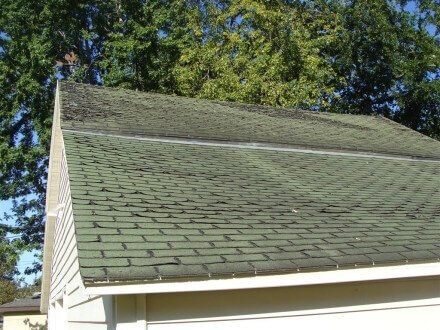
Curled Shingles
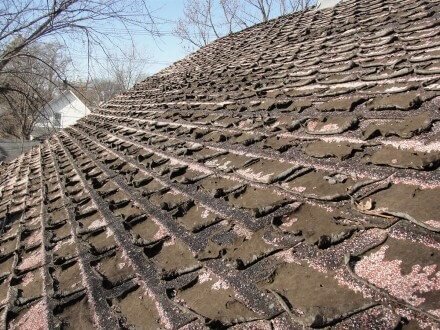
Severely Deteriorated Shingles
Look out for cracks in shingles as well. These typically won’t be visible on second-story roofs, but it’s sometimes possible to spot these on single-story roofs.
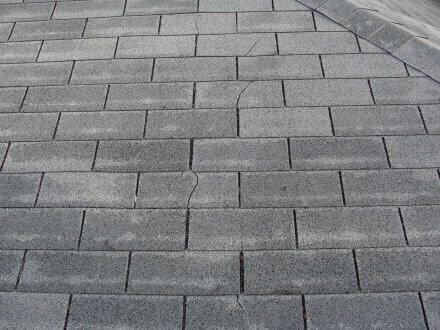
Cracks in shingles
Mis-matched or patched shingles, missing shingles, and shingles sliding out of place typically indicates an improper installation. The photo below shows a horrible patch job. And while a new roof means you won’t have deteriorated shingles, this doesn’t mean it’s a perfect roof. We’ve found many new construction homes with shingles that weren’t installed properly, which leads to shingles blowing off the roof.
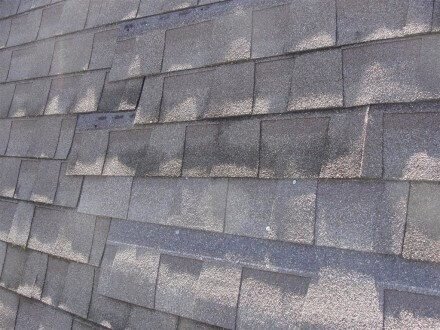
Hack patch job
Always look for loose shingles in valleys.
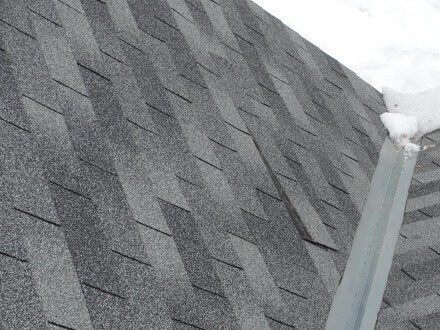
Loose shingle
A large section of the roof below had been patched. Why was the roof patched to begin with? A patched roof is often the result of an improper installation that has led to shingles coming loose.
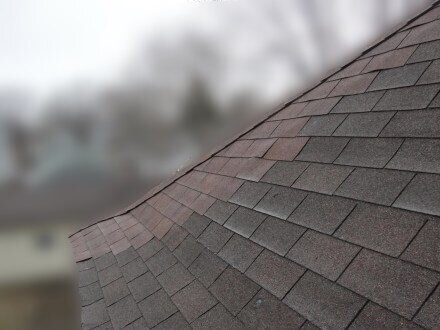
Mis-matched shingles
Shingles without neat rows may have been installed that way, but it may also mean that shingles are beginning to slide down. Closer inspection of the roof below revealed shingles that were improperly nailed, causing them to slide down.
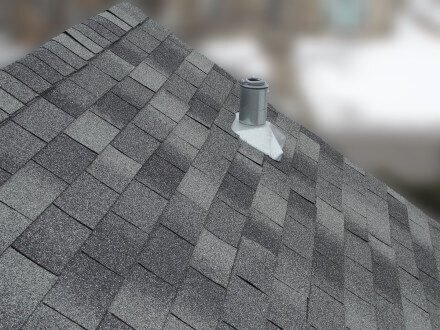
Slipping Shingles
Here’s a more extreme example of sliding shingles.
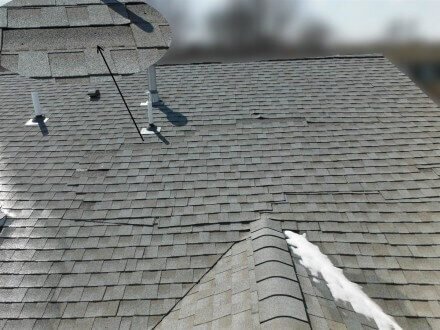
Sliding Shingles
Don’t forget to view all sides of the roof. This next roof was too high to be safely inspected with a 28′ extension ladder, but a walk down the alley revealed considerable, obvious damage. Our client was completely unaware of this damage simply because they hadn’t taken a walk down the alley to see it.
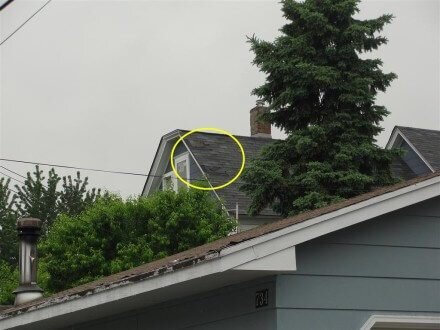
Damaged shingles
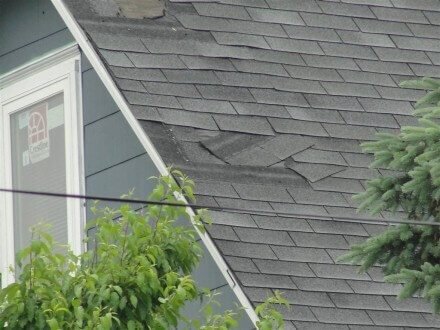
Damaged shingles close-up
Chimney Problems
Chimney repairs are usually expensive. If you’re buying an older house with a masonry chimney, take a close look at it. Missing mortar between the bricks typically won’t be a major repair, but missing bricks and large cracks in the walls might mean the upper portion of the chimney needs to be re-built.
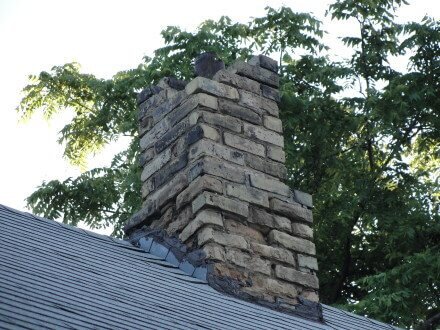
Missing bricks at chimney
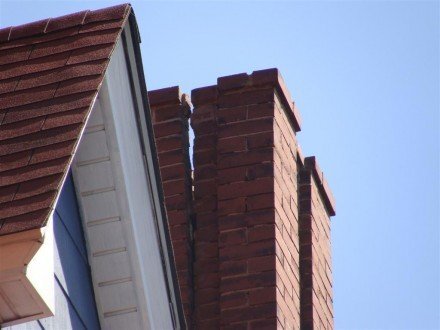
Cracked chimney
As with roofs, be sure to look at every side of every chimney. The chimney shown below had been redone to look good from the street, but didn’t look so great from the back yard. Yes, that’s the same chimney on the same day.
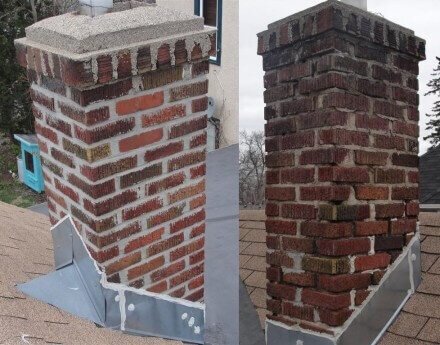
Yes, this is the same chimney on the same day!
Also, be wary of stucco-covered chimneys on homes built in the early 1900s. Cracks in the stucco, patching, or damaged areas often indicate concealed damage.
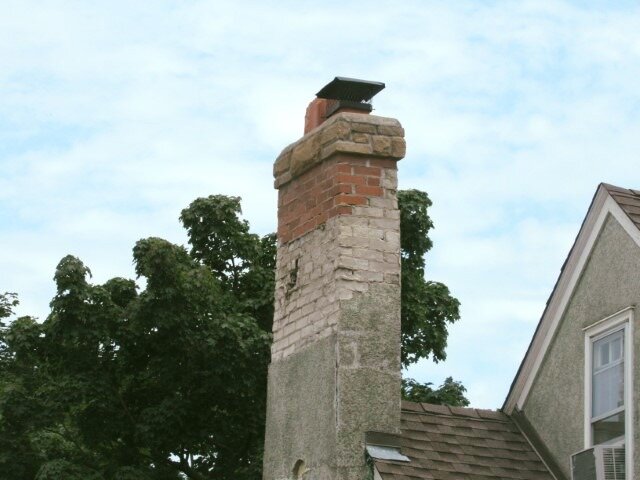
Neapolitan chimney
Check out my blog post on stucco-covered chimneys for more detailed information. Problems with the chimney flashing and crown can be a big deal, but these are difficult to identify from the ground, and problems with chimney flues are very difficult to find without a level 2 chimney inspection, which is a specialized inspection that’s done with a fiber-optic camera.
Siding
Hardboard siding begins to swell and then literally falls apart when it rots. Deteriorated hardboard siding is usually quite easy for anyone to spot. Check the north sides, areas not protected by soffits (overhangs), and the areas closest to the ground first; these will be the first areas to rot. If you’re unsure about an area, push on it with your finger, but not too hard. When hardboard siding is badly rotted, it gets mushy.
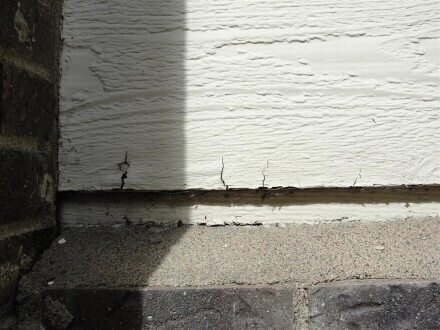
Cracked hardboard siding
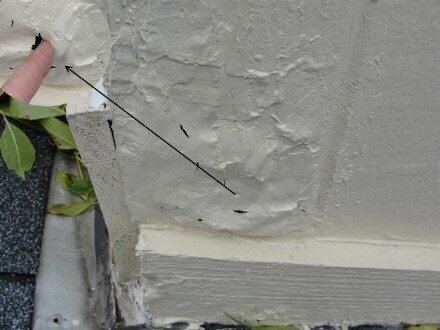
Hardboard siding rotted and patched
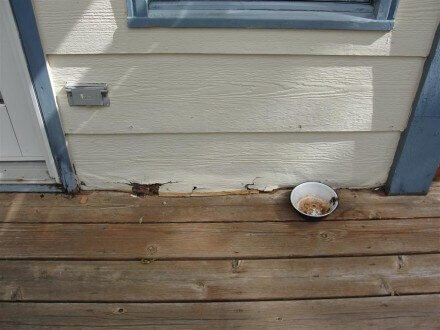
Rotted hardboard siding
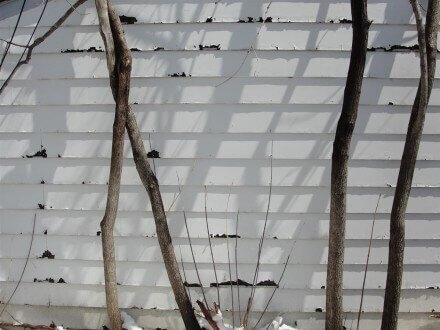
Severely rotted hardboard siding
Defects with newer stucco siding (late 1980s through today) are difficult to identify from the exterior, but stains below windows are an obvious warning sign that there may be hidden damage.
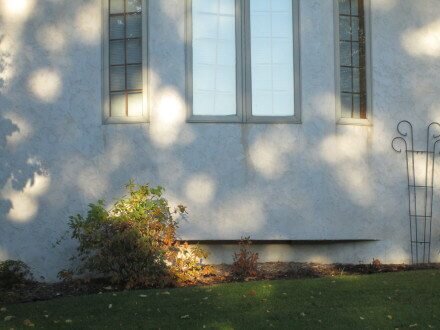
Stains below windows
If you’re buying a home with newer stucco siding, plan to have stucco testing performed. A high percentage of newer stucco homes experience water intrusion problems. If your home has stone veneer siding, treat it the same way you would stucco. It performs exactly like stucco, but the installations are typically far worse.
Problems with other types of siding usually aren’t as easy to spot without a trained eye… but I can still help you with that. If you’d like to have a semi-trained eye for identifying major water problems, check out my free 85-minute class on how to find water problems at siding. This is a class that I made for internal use only but later decided to make public. While it’s meant for home inspectors at my company, I use layman’s terms to make it easy for anyone to understand. And I have a double-your-money-back guarantee that you’ll learn something and you won’t be bored.
Windows
Rotted wood windows that have been patched may look fine from a distance, but it’s usually easy to spot damaged areas when you’re up close. Give the windows a little poke with your finger when you suspect rot. Sometimes the patchwork will be paper-thin, so don’t poke too hard.
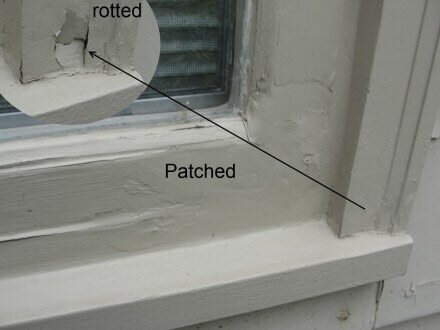
Rotted Windows
Aluminum clad wood windows can completely rot apart on the inside, yet leave no visible evidence on the exterior. The most problematic time period for these windows was approximately 1990 up until about 2005. These windows can be pushed on or squeezed to help determine if there is internal rotting. The windows that will rot first are the ones that aren’t protected by soffits, aka overhangs.
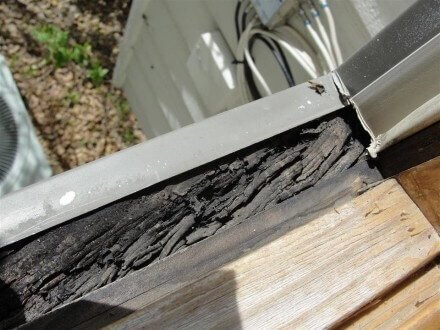
Rotted Aluminum Clad Windows
In the photo below, I pulled some of the cladding back to show severely rotted wood inside the sash.
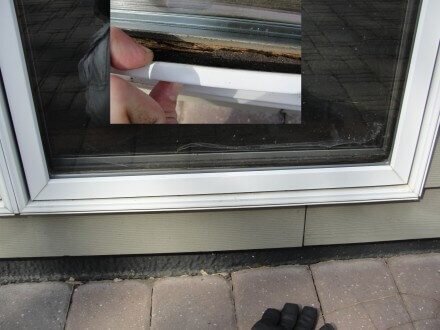
Rotted Aluminum Window
I also recommend cranking windows open and looking at them from underneath, as this can sometimes reveal water damage. On houses where I’m especially concerned, I’ll start my inspection by going inside the house, cranking open every single window, then conducting my inspection of the exterior. This way, I can clearly see the underside of every wood window frame.
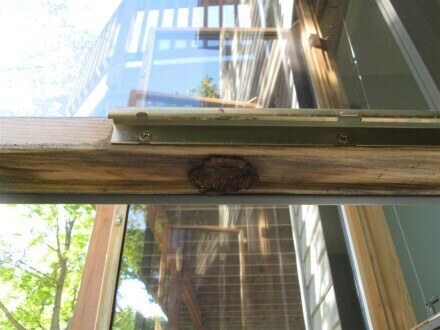
Rotted aluminum clad window
Water Management
This one is huge, and it ties in very closely with looking for problems with siding. To fully understand this, watch the 85-minute video that I linked to above. It’s so important that water is properly directed away from the home. Look for proper gutters, downspouts, and downspout extensions. They’re not required, but they make a huge difference. Also, check to make sure the ground slopes away from the house. Water draining towards a house can lead to big water problems in the basement or crawl space, as well as foundation problems.
Look at rooflines as well; if water gets concentrated against the house, the potential for water intrusion goes up. The photo below shows a good example of several roof surfaces concentrating water into a small area at the house.
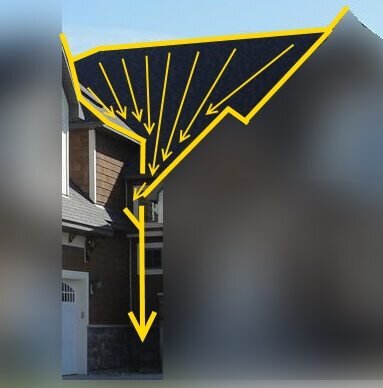
Water concentrated against house
Decks
Always look underneath decks. Sometimes decks will have a fresh coat of paint that conceals severe rotting, which may be quite visible from below.
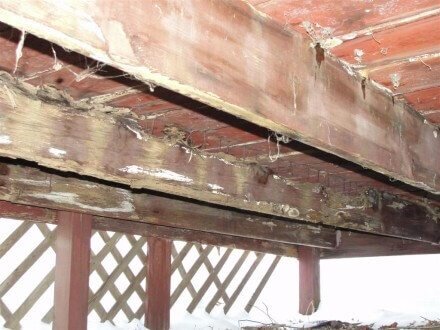
Rotted deck joists 2
Take a step back from the deck and look for sagging, which may indicate a structural problem. The deck shown below had a very noticeable sag in the middle which wasn’t obvious from up-close.
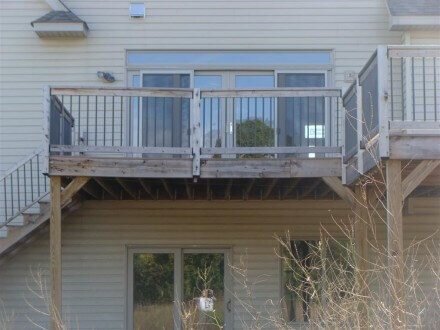
Sagging Deck
Check out the guardrails too. Push on the tops of them all around the deck to make sure they’re not wobbly. Pay special attention to guards that have aluminum balusters going into wood bottom rails. There is no way to keep water out of the wood, and you have a sure recipe for advanced rot.
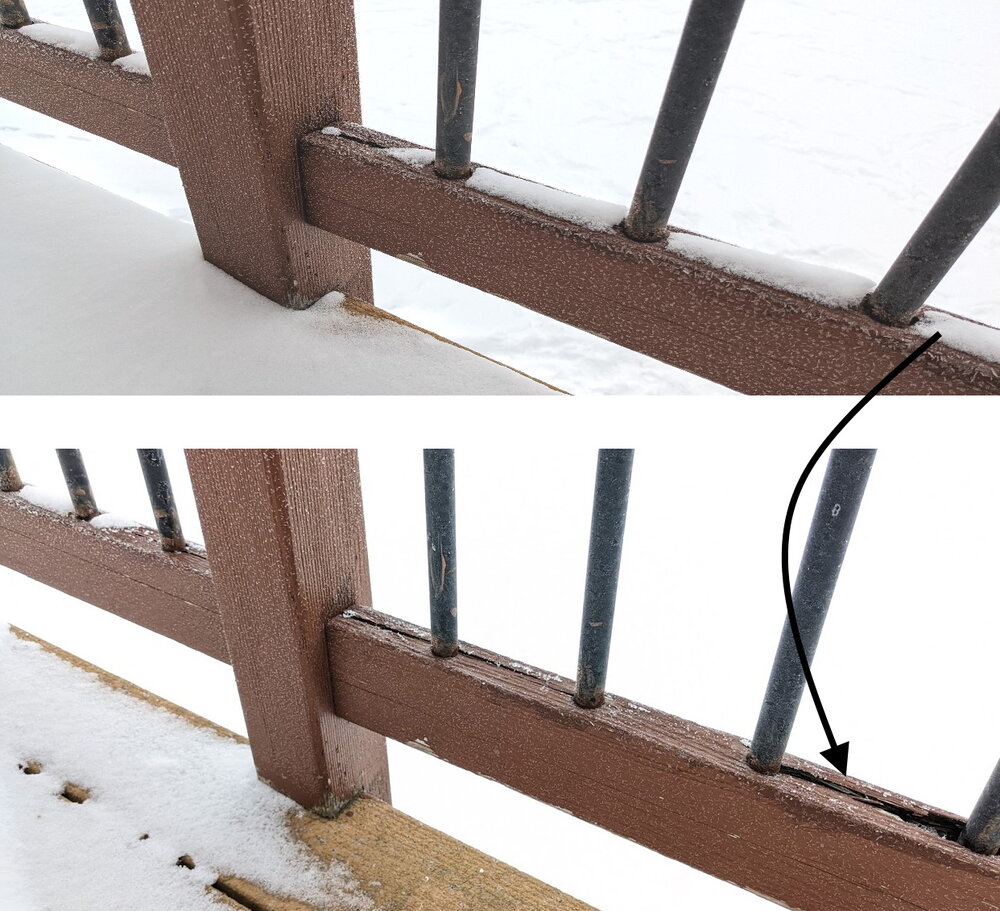
It’s tough to see this type of damage after it has snowed, which is why it’s especially helpful to know where to look a little bit harder.
Next week I’ll have a home inspection checklist for the interior, along with a one-page pdf checklist of these interior and exterior items.
